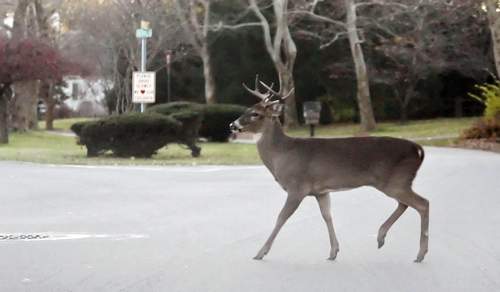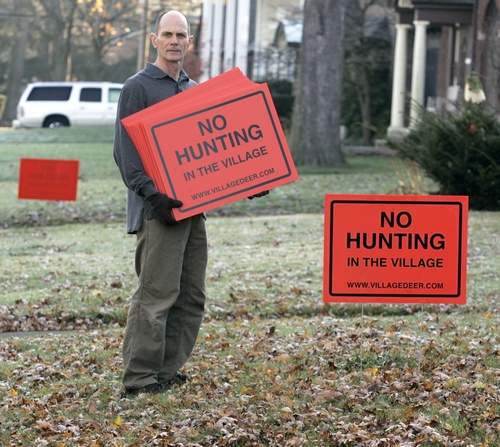IN OTTAWA HILLS' LINE OF FIRE
Article published November 15, 2009
|
A doe accompanied by two fawns drops dead in Cascade Valley Park near Akron from a bullet in her head.
Her life is one of many that will be taken that year by sharpshooters assigned to thin out the Summit County Metroparks system's burgeoning deer population.
But is she really dead?
A nine-minute undercover video filmed by an Illinois-based animal rights group shows the deer's hind legs twitching and jerking.
Though biologists have said it's normal for an animal to have muscle and nerve spasms after taking a bullet to the head, some are left wondering.
An activist group called Showing Animals Respect and Kindness, or SHARK, contends the deer in the video was killed inhumanely and suffered. It claims the doe was still alive when a park ranger put a plastic bag around her head.
The firm that carried out the Akron-area hunt, White Buffalo Inc. of Connecticut, is under consideration for a selective killing of deer, known as a cull, in Ottawa Hills next year.
Ottawa Hills residents have taken sides in what Rob Slater and others are calling a civil war. Mr. Slater has chosen his side and is posting signs expressing his and other residents opposition.
No matter how people feel about the ethics of controlling wildlife populations, to many, it's an ugly and messy business.
Ottawa Hills Village Council's plan to authorize the cull has evoked emotional responses, including a yard-sign campaign.
"I believe very firmly most people are opposed to the cull. But there are people who feel very strongly the other way," said Rob Slater, an Ottawa Hills resident and manager of a Detroit chemical plant who is involved in the opposition movement. It's clear there is very little middle ground. We're starting to call it our civil war.
|
License to kill
Last week, the Ohio Department of Natural Resources sent the village a state permit to have up to 50 deer killed. Though that's nearly half the 104 deer believed to be in Ottawa Hills, the population is expected to expand by 30 percent a year, Village Manager Marc Thompson said.
Next up is a pivotal vote before Village Council on Nov. 23. At the 7:30 p.m. meeting inside Ottawa Hills Elementary School, council is expected to amend a 1940 ordinance so that firearms can be discharged within the village to kill the deer.
If all goes as planned, the village will hire a contractor to orchestrate the cull.
Jim Walter, chairman of the council's services and environment committee, said officials are eyeing a February-March timeframe for the cull. They would prefer to hire a contractor at an anticipated cost of $25,000 to $30,000 instead of enlisting local hunters "because of liability and public relations," he said.
White Buffalo Inc.
The only firm village officials have discussed the matter with is White Buffalo, which has become nationally known for culling deer.
In fact, it is the only such company the Ohio Department of Natural Resources knows about that traverses the country, according to Scott Peters, an assistant wildlife management supervisor for the state agency who has overseen recent culls in Akron and other parts of northeastern Ohio.
White Buffalo began culling deer from Cleveland Metroparks 13 years ago. It moved into the Cleveland suburb of Solon, Ohio, in 2005.
White Buffalo was at the center of controversy when SHARK filmed the 2004 undercover video footage near Akron, just as it has been in several other states where it has culled deer, such as California, New Jersey, Missouri, Texas, Virginia, Minnesota, and Maine.
"They've had controversy every place they've gone," Steve Hindi, SHARK president, said.
But White Buffalo has established a foothold in the communities where it has been, getting contracts renewed for repeat business.
Opponents claim communities are getting suckered into financial black holes, throwing good money after bad.
White Buffalo's supporters, which include ODNR officials and area politicians, said the company must be well-received if it continues to be called back.
Anthony DeNicola, White Buffalo's co-founder and president, brings more credentials to the debate than an ordinary deer hunter. His Web site said he received a doctorate in wildlife ecology in 1996.
Mr. DeNicola said he doesn't want to mislead anyone into thinking culls are a one-time deal. He likened deer management to mowing lawns - that is, it requires regular maintenance.
"If somebody's thinking one year, I'll tell them not to waste my time," Mr. DeNicola said.
The secret video
SHARK obtained its footage of the Akron cull by sneaking about 10 cameras into Cascade Valley Park before the shooting began. The cameras were hidden near bait stands that had been set out to attract deer.
The American Veterinarian Medical Association's latest euthanasia guidelines for wildlife state that "the preferred target area should be the head."
"A gunshot to the heart or neck does not immediately render animals unconscious and thus is not considered to meet the panel's definition of euthanasia," the association guidelines state.
Mr. DeNicola's contention is that a single shot to a deer's head blows off about a third of the animal's brain tissue, effectively making it brain dead upon the bullet's impact.
He said the twitching seen in the video was natural. He called it the "chicken-with-the-head-cut-off phenomenon."
"The bottom line is, they took one shot per deer," Mr. Hindi said.
He noted how former White House Press Secretary Jim Brady survived after he was shot in the head during the assassination attempt on former President Ronald Reagan in 1981.
"I wouldn't deny that [the Akron deer in the video] were mortally wounded. But when an animal responds to being touched, that's not a dead animal," Mr. Hindi said.
The activist group's plan was to get additional footage each day. Eventually, one of the cameras was spotted. The cull was suspended until other cameras were rounded up.
Mr. DeNicola admittedly deleted footage, saying he did so to protect rangers he'd trained from retaliation.
Mr. Hindi said he believes Mr. DeNicola was erasing gruesome footage he did not want the public to see.
SHARK took White Buffalo to federal court, claiming its cameras were illegally seized and damaged.
Even though it had received a favorable ruling in the case, White Buffalo recently settled its dispute over the video cameras for $17,500. Mr. DeNicola said his insurance company offered the settlement to avoid the cost of more litigation.
WARNING: MATURE CONTENT
This video contains images of deer being killed and may be disturbing to some viewers. It was recorded in Cascade Valley Park near Akron by the animal-rights group Showing Animals Respect & Kindness.
Many of those opposed to culling deer suggest contraception as an alternative.
It is not even an option in Ohio.
Scott Butterworth, supervisor of ODNR's wildlife management district for much of northwest Ohio, said the state does not allow contraception. A study of deer in the Columbus area about 10 years ago showed that "chemical sterilization is not effective on free-ranging suburban deer," Mr. Butterworth said.
Activist Lane Ferrante of Bedford, Ohio, said she and others who protested the cull in Solon tried to distract Mr. DeNicola's people by videotaping them and setting up alternative food stands for the deer.
"If it's so humane, why do they go to such extremes not to let anybody watch or take videos?" Ms. Ferrante asked.
Mr. DeNicola said it serves no purpose to let the public watch.
Accountability
Ms. Ferrante said her experiences with White Buffalo prompted her this year to establish an Ohio chapter of the League of Humane Voters. It is a political action group that seeks to hold public officials accountable for their votes on animal-related issues.
As the group's state director, she said it will try to hold Ottawa Hills councilmen accountable for their votes on Nov. 23.
Mr. DeNicola has no regrets about how activists have been treated. "The folks that are belligerent will get arrested," he said.
The Ottawa Hills' controversy has led to the establishment of a local citizens' group, villagedeer.com, which opposes the cull.
The group last week began putting up 200 yard signs. It has started an online petition and it had plans to put flyers on doorknobs this weekend, Mr. Slater said.
He's opposed to the cull, Mr. Slater said, because "it's so expensive and there's nothing to suggest it's going to improve our situation."
Mr. DeNicola agreed that humans are partly to blame for trampling on traditional deer habitat as homes and businesses are developed in areas that had been undisturbed.
"From my perspective, I'm cleaning up people's messes," Mr. DeNicola said. "How do you try to re-create a balance, if that's possible, in an environment that's been disturbed?"
Meanwhile, many communities across the United States wait, trying to see what their neighboring cities and towns are doing to address the problem as both human and deer populations rise.
"The problem is ubiquitous," Mr. DeNicola said. "But politicians are soft."
Contact Tom Henry at:
This email address is being protected from spambots. You need JavaScript enabled to view it.
or 419-724-6079.







